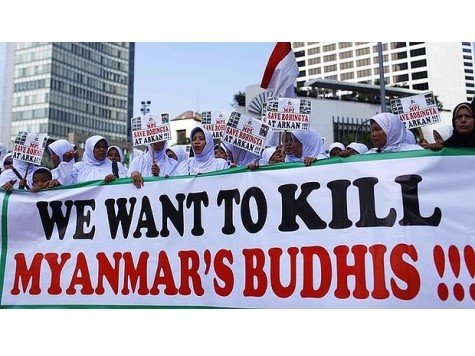
The New York Times published a rather one-sided article about the growing anti-Islam movement in Myanmar. Muslims are a minority there and the country’s Buddhists monks are voicing a growing concern about the Muslim residents.
‘You can be full of kindness and love, but you cannot sleep next to a mad dog,’ Ashin Wirathu said, referring to Muslims.
‘I call them troublemakers, because they are troublemakers,’ Ashin Wirathu told a reporter after his two-hour sermon. ‘I am proud to be called a radical Buddhist.”
The Times describes Ashin Wirathu as having a “rock star” following and goes on to describe:
But over the past year, images of rampaging Burmese Buddhists carrying swords and the vituperative sermons of monks like Ashin Wirathu have underlined the rise of extreme Buddhism in Myanmar — and revealed a darker side of the country’s greater freedoms after decades of military rule. Buddhist lynch mobs have killed more than 200 Muslims and forced more than 150,000 people, mostly Muslims, from their homes.
Citing the Dalai Lama and other Buddhist scholars and figureheads, the Times described this response to Islam as “unthinkable” and an anathema to Buddhism. “Myanmar monks are quite isolated and have a thin relationship with Buddhists in other parts of the world,” Phra Paisal, a Buddhist scholar said.
Wirthau’s movement calls itself 969, “digits that monks say symbolize the virtues of the Buddha, Buddhist practices and the Buddhist community.” Stickers and logos can be found all over the nation.
The New York Times isn’t telling the other side of the story, choosing only to describe this movement as if it were a spontaneous attack on the Muslim minority in Myanmar.
So what caused this increase in anti-Islamic sentiment?
It starts with a group known as the Rohingya Muslims. The Rohingya Muslims are classified by the Myanmar government to be immigrants, they are not considered to be indigenous to Myanmar having come into Myanmar from Bangladesh, although there is some disagreement about the issue. The Rohingya are not eligible for citizenship in Myanmar (formerly known as Burma).
The genesis of the recent conflicts can be found around May of last year, when a 27-year-old woman named Ma Thida Htwe was raped and murdered by local Muslims, the Rohingya. Following this rape and murder, 10 Muslims were killed when their bus was intercepted by Buddhists as the bus was traveling in the province. This was an act of retribution, as the police (Buddhists) refused to turn over the perpetrators to the angry community for punishment. “The attack followed the distribution of leaflets in Rakhine calling for retribution for the gang rape and killing of a young Buddhist woman several days earlier” according to Reuters.
As concern grew in India about a slaughter of Muslims in Myanmar, the Indian Ambassador to Myanmar clarified, “the photos of mass killings of Muslims as fake and described the reports as baseless accusations. He further said that the violent clashes began after the rape and murder of a Buddhist girl by three Muslims in Rakhine State on 28th May.” There is more information here about propaganda regarding the Burmese slaughter of Muslims.
Another incident came after a short period of calm in the region in June of 2012, when 60 Muslims were arrested after the bodies of 12 Buddhists were found in Yathetaung township. “Those arrested carried knives, rods and sharpened sticks,” police said.
Tensions only got worse on July 13, 2012, when Islamic hardliners called for Jihad in Myanmar outside the Indonesian capital of Jakarta. Said a participant, “Every drop of blood that is shed from a Muslim must be paid back. Nothing is free in this world,” the man shouted, as protesters carried banners that read “FPI is ready to wage jihad. Go to Myanmar and carry out jihad for your Muslim brothers.”
Similar incidents persist this year. In 2013, there was a confrontation resulting in the death of 40 people. A Buddhist couple had gone into a Muslim-owned gold shop to sell some jewelry. “A dispute over the price escalated into a bigger fight and after a Buddhist monk died as the result of an attack, a sustained mob assault on Muslim areas began.” Entire Muslim neighborhoods were destroyed and 12,000 Muslims are said to have fled the country.
With calls for Jihad against Myanmar as recent as last month, it is clear the Buddhists in Myanmar are trying to defend against an attack on their country, not just by the minority of Muslims who live there but among Muslims around the world. In 2001, the Taliban blew up two 1700 year old statues of Buddha with dynamite claiming that while the statues were part of Afghanistan’s history, “the part that contradicts our Islamic beliefs we would not like to have them any more.” Perhaps the Buddhists are trying to maintain their own history and culture in the face of calls for destruction.

COMMENTS
Please let us know if you're having issues with commenting.